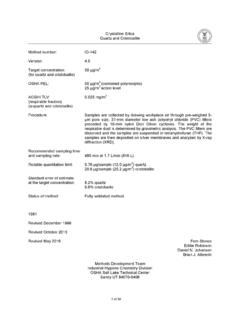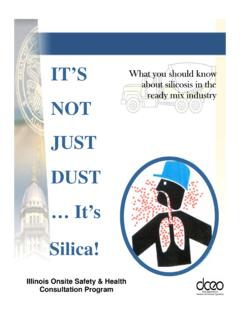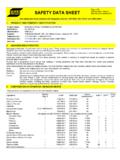Transcription of SILICA, Respirable Crystalline, by IR (KBr pellet) 7602
1 NIOSH Manual of Analytical Methods (NMAM), Fifth Edition silica , Respirable crystalline , by ir (KBr pellet) 7602 SiO2 MW: CAS: 14808-60- 7 RTECS: VV7 330000 ( quartz ) 14464-46- 1 VV7325000 (cristobalite) 15468-32- 3 VV335000 (tridymite) METHOD: 7602, Issue 4 EVALUATION: FULL Issue 1: 15 February 1984 Issue 4: 25 July 2017 OSHA: mg/m3 NIOSH: mg/m3; carcinogens OTHER OELS: [1,2]PROPERTIES: solid; d g/cm3; crystalline transformation: - quartz to - quartz @ 573 C; quartz to tridymite @ 867 C; tridymite to cristobalite @ 1470 C SYNONYMS: free crystalline silica ; silicon dioxide SAMPLING SAMPLER: CYCLONE + PRE-WEIGHED FILTER (PVC), with conductive filter holder FLOW RATE: ~2 to ~4 L/min, specific for the cyclone used VOL-MIN: 400 L -MAX: 1000 L (total dust < 4 mg) SHIPMENT: Routine SAMPLE STABILITY: Stable BLANKS: 3 field blanks minimum per sample set ACCURACY RANGE STUDIED: 5 to >160 g BIAS: Varies depending on matrix effects OVERALL PRECISION ( ): [3] ACCURACY: 19% at 40-160 g per sample; 36% at 15 g per sample [4] MEASUREMENT TECHNIQUE: INFRARED SPECTROMETRY ANALYTE: quartz / Cristobalite ASHING: Muffle furnace or RF plasma asher PELLET: Mix residue with KBr.
2 Press 13-mm pellet IR DETECTION: Scan absorbance between 400 cm-1 and 1000 cm -1 CALIBRATION: Certified reference material (CRM) Respirable crystalline silica (RCS) quartz & cristobalite; , NIST SRM 1878b quartz , NIST 1879a cristobalite, and/or other RCS CRMs; diluted in KBr and pressed into 13-mm pellet RANGE: 10 to > 160 g ESTIMATED LOD: 5 g PRECISION ( ): < @ 30 g per sample APPLICABILITY: The working range is to mg/m3 for a 400-L air sample or to mg/m3 for a 1000-L air sample. quartz and cristobalite have a major IR absorbance band at 800 cm-1 and can be measured together if present in samples; tridymite can also be measured by ir , but its presence is rare in workplaces [5-9]. INTERFERENCES: Amorphous silica , kaolinite, muscovite, talc, albite, vermiculite and other minerals that absorb IR radiation in the 800 cm-1 region are potential interferences to RCS measurement [5,10] [Table 1].
3 Potentially interfering silicates can be removed using a phosphoric acid cleanup procedure [11]. Calcite at >20% dust loading can negatively interfere by reacting with quartz during muffle ashing [11, 12]. The sample preparation procedures described in this method enable minimization of interferences. OTHER METHODS: NIOSH Method 7603 describes IR measurement of Respirable crystalline silica (RCS) after redeposition onto a filter for analysis (vs. use of a KBr pellet) [13]. X-ray diffraction ( , NIOSH Method 7500 [13]) is a complementary method for RCS measurement. An international voluntary consensus standard describing the measurement of RCS by ir spectrometry, ASTM D7439, has been promulgated [14]. Respirable crystalline silica by ir (KBr Pellet): METHOD 7602, Issue 4, dated 25 July 2017 - Page 2 of 7 NIOSH Manual of Analytical Methods (NMAM), Fifth Edition REAGENTS: 1.
4 Respirable crystalline silica (RCS) primary certified reference materials (CRMs); , NIST SRM 1878b ( quartz ), NIST SRM 1879a (cristobalite) [15]. 2. Potassium bromide (KBr), IR quality. 3. Kaolinite (kaolin) CRM. 4. Deionized water, 18 M -cm resistivity. 5. 2- Propanol, reagent grade. 6. Ethanol, 95%, for cleaning of sample handling equipment.* 7. Hydrochloric acid (HCl), 9% w/w.* Add 25 mL conc. HCl (37% w/w) to 50 mL of deionized water, cool, and bring to 100 mL with deionized water. 8. Calibration stock standard, w/w. Accurately weigh and thoroughly mix 5 g KBr (dried overnight at 110 C) with 25 mg quartz . Store in a bottle in a desiccator. *See SPECIAL PRECAUTIONS. EQUIPMENT: 1. Sampler: a. Filter, 37-mm dia., 5- m pore size, polyvinyl chloride (PVC), supported with backup pad or screen in 2-piece, conductive / static-dissipative filter holder.
5 B. Cyclone, Respirable , designed to operate at a flow rate of 2 or 4 L/min, specific for each sampling device. c. Sampling head holder, for keeping the cassette, cyclone and coupler tightly together so that air enters only through cyclone inlet. 2. Personal sampling pumps, for RCS sample collection at 2 or 4 L/min. 3. Infrared spectrometer, double-beam dispersive or Fourier transform device, with 4 cm-1 resolution or better. 4. Laboratory press (10 tons pressure), for preparing KBr pellets, with evacuable 13-mm KBr pellet die. 5. Vacuum pump, for connecting to laboratory press. 6. Low-temperature (RF plasma) asher and aluminum weighing pan, or muffle furnace and porcelain crucibles. 7. Analytical balance, capable of weighing to the nearest mg. 8. Mortar and pestle, 50-mm agate or mullite 9. Metal microspatula 10. Non-serrate, non-magnetic forceps 11.
6 Desiccator 12. Camel s hair brush 13. Glassine paper / weighing boats 14. Membrane filtration apparatus (47- mm) 15. Laboratory oven SPECIAL PRECAUTIONS: Wear appropriate personal protection during sampling activities, sample preparation and analysis. It is essential that suitable gloves, eye protection, laboratory coat, etc., be used, especially when working with concentrated acids. Note that KBr is incompatible with strong acids. Ethanol and 2-propanol are flammable. Avoid exposure by inhalation of silica dust or acid fumes. Perform sample preparation and analysis in a clean, well-ventilated area that is well removed from any possible contamination. Any skin affected by exposure to acids must be immediately washed with plenty of water. Respirable crystalline silica by ir (KBr Pellet): METHOD 7602, Issue 4, dated 25 July 2017 - Page 3 of 7 NIOSH Manual of Analytical Methods (NMAM), Fifth Edition SAMPLING: 1.
7 Calibrate each personal sampling pump with a representative sampler in line. Use a conductive filter holder. 2. Sample at 2 L/min [16] or 4 L/min [17] using a pump set at a specific flow rate for the selected cyclone, designed to collect the Respirable aerosol fraction (in accordance with ISO 7708[18]), for a total sample size of 400 to 1000 L. Take care not to overload the filter. NOTE 1: Do not allow the sampler assembly to be inverted at any time when using a cyclone. Turning the cyclone to anything more than a horizontal orientation may deposit oversized material from the cyclone body onto the filter. NOTE 2: Higher sampling flow rates may be suitable for certain sampler designs [19]. 3. After collection of samples, remove the filter holders from the cyclones. Seal the filter holders (cassettes) and transport them to the laboratory in a container designed to prevent damage in transit.
8 SAMPLE PREPARATION: 4. Use one of the following methods to prepare samples and blanks: a. Low-temperature (RF plasma) asher: Remove the filters from filter holders and place them in clean, labelled aluminum dishes. Place the dishes in the low-temperature asher so that sample exposure to the plasma is optimized. Ash the samples according to manufacturer s instructions. Carefully bring the asher to atmospheric pressure and remove the dishes. b. Muffle furnace: For samples expected to contain a significant amount of calcite (>20% of the total dust loading), wash filters with 9% w/w HCl per procedure in For other samples, proceed to step i. Place a m pore size, 47-mm dia. PVC filter in the filtration apparatus. Remove the 37-mm dia. sample filter from the filter holder and center atop the 47-mm PVC filter. Clamp a funnel over the frit so that the dust deposit on the filter is completely exposed to rinsates.
9 Add 10 mL of 9% HCl and 5 mL of 2-propanol; allow to stand for 5 min. Apply vacuum and slowly aspirate the acid and alcohol in the funnel. Wash with three successive 10-mL portions of deionized water. Release vacuum. ii. Place 37-mm filter samples and blanks in porcelain crucibles, loosely cover, and ash in muffle furnace for 2 h at 600 C (800 C if graphite present). Allow to cool to room temperature. 5. Add approximately 300 mg KBr, weighed to the nearest mg and dried overnight at 110 C, directly to each sample. Mix the sample residue (remaining from the above ashing procedure) with KBr using a pestle and grind / homogenize the mixture with mortar and pestle. Quantitatively transfer the mixture to a 13-mm evacuable pellet die using glassine paper and camel s hair brush. Place the die into the laboratory press and apply requisite pressure to prepare the sample KBr pellet.
10 Weigh the finished pellet to the nearest mg and calculate the ratio of the weight of the finished pellet to the weight of KBr initially added. Clean sample handling equipment with ethanol between samples. CALIBRATION AND QUALITY CONTROL: 6. Prepare at least 5 working standard KBr pellets. Calibration standards shall be prepared from primary RCS CRMs. NOTE: Suitable RCS standards include primary reference materials such as NIST SRMs 1878b ( quartz ) and 1879a (cristobalite) [15]; the use of secondary reference materials as calibration standards is not appropriate for IR measurements [12, 20]. a. Weigh, to the nearest mg, portions of primary CRMs containing 10 to 200 g RCS of material. b. Add an accurately weighed (to the nearest mg) 300 mg portion of KBr. Prepare KBr pellet samples as in Step 5. Compute the ratio of the weight of finished pellet / weight of solids added.

















